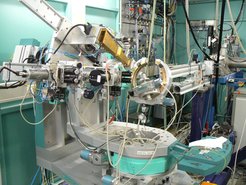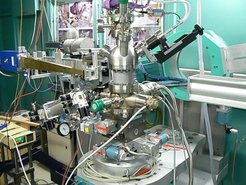Instrumentation
The heart of the experimental end station is a 2+3 diffractometer that can be operated either in a mode with horizontal or vertical orientation of the sample normal.
The sample stage has 4 degrees of freedom in the vertical configuration and 5 degrees of freedom in the horizontal configuration. The vertical axis sample rotation stage can support a weight of up to 200 kg (500 kg without tilt and translation). The detector arm has in addition two degrees of freedom combined with the possibility of slit rotation on top of the detector arm. All rotations provide an angular resolution of 0.0002°. The detector arm itself is designed to support two detectors simultaneously. The whole instrument is aligned in the incident X-ray beam using a jackable table. Two motorized horizontal and vertical slits are mounted on the detector arm. In front of the instrument another pair of slits is defining the incident beam size. Behind the incident slits an ionization chamber is installed to monitor the incident photon flux.


As standard sample environments, there are available:
- Furnace: TC-DOME (Bruker), RT-1200°C or -180°C - +400°C
- Cryostat:
- Oxford Coolstar 2/9, 12K base temperature
- APD Displex 6K base temperature
- 4He/3He Cryostat >1.5K
- Ambient conditions:
- Kapton dome flushed with 4He
- Be dome evacuated
The portfolio of detectors includes:
- Point detectors for beam and sample alignment as well as reflectivity measurements
- Pin diode
- NaI and LaCl3 scintillation detector
- Avalanche photo diode
- 1D photon counting silicon strip detector
- Mythen 1K, high angular resolution for fast 2D reciprocal space maps
- 2D photon counting silicon pixel detectors for fast 3D reciprocal space maps
- Pilatus 100K, medium resolution
- Eiger 500K, high resolution with at maximum 9 kHz repetition
Especially, with the new 2D pixel detectors (Eiger, Pilatus) 3-dimensional intensity distributions of the diffracted intensity can be measured very fast in a single scan and immediately analyzed with the installed software package “Binoculars”. Reciprocal space maps based on Mythen data are analyzed with our software package “Mythen”.

